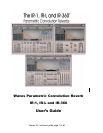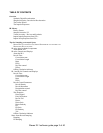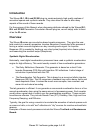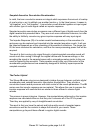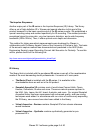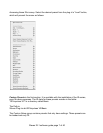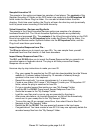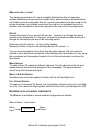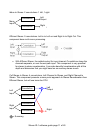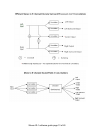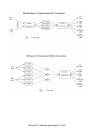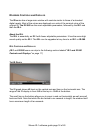Introduction
The Waves IR-1, IR-L and IR-360 plug-ins create extremely high quality replicas of
acoustical spaces and synthetic reverbs. They also allow the user to alter many
aspects of the sound of these reverbs.
For the purpose of this Manual, when discussing attributes shared by the Waves IR-1,
IR-L and IR-360 Parametric Convolution Reverb plug-ins, we will simply refer to them
all as the IR-series.
Overview
The Waves IR-series are convolution-based reverb processors. They give the user
total control of a reverb's properties. Impulse Response Convolution is the process of
forcing a certain acoustic signature on any incoming audio signal. An Impulse
Response (IR) is created by feeding a very short pulse (Impulse) into a linear system
and measuring the resultant output (Response).
Synthetic Digital Reverberation
Historically, most digital reverberation processors have used a synthetic reverberation
engine for high efficiency. This would usually consist of two reverberation generators:
• The Early Reflections Generator. This generator is based on a short Finite
Impulse Response (FIR) filter with less than 100 reflections. A short stage of
convolution is performed with this FIR.
• The Reverberation Tail Generator. This is based on a recursive Infinite Impulse
Response (IIR) filter. The IIR comprises a feedback loop with a decay factor and
inner dispersion filters. It makes the reverb more complex, less resonant, and
more rich and natural sounding.
The tail generator is efficient. It can generate a one-second reverberation time or a five-
second reverberation time using the same amount of processing power. Such reverbs
usually allow a great deal of control over the reverberation properties. These controls
have become classics. They include Reverb Time (RT), Predelay, Size, High and Low
Frequency Damping, and Diffusion.
Typically, the goal for using a reverb is to emulate the acoustics of natural spaces such
as rooms or halls, or to add "wet" reflections to "dry" sources for creative and aesthetic
reasons.
Examples of these reverb processors include the Waves TrueVerb and Renaissance
Reverb.
Waves IR-1 software guide page 4 of 40



